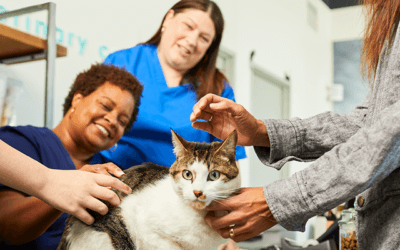The number one reason why people don’t bring their cat to the vet is because their cat doesn’t like it. The number one reason that people do bring their cat to the vet is because they are sick. We all know that once a cat begins to show signs of illness, it is possible that the cat has been sick for some time. To encourage our clients to bring their feline friends to visit more regularly and ensure our practice is more cat-friendly, we have begun to implement Fear Free tactics, especially for cats.
[bctt tweet=”Fear Free helps practices become cat-friendly.”]
The Fear Free initiative is a rapidly growing and popular movement that helps veterinary professionals like you and I make vet visits easier for all pets. Fear Free offers online and in-person training on how to recognize signs of fear, anxiety and stress in pets, proper restraint techniques for a less stressful visit and even recommendations on how to use pre-visit pharmaceuticals to help calm a pet prior to the office visit—plus a lot more! An individual or an entire practice can become certified in Fear Free techniques and each year they offer a new curriculum and resources so that you or your staff are constantly learning.
I am the only Fear Free certified® individual in my clinic, but I try and implement all of the tips and techniques that I have learned to make for better pet visits. Today I will share a tiny portion of what I have learned. These tips are simple and easy to implement and help make a vet visit much easier for a cat, which also improves our bonding rate with the client!
Educate clients on how to create a cat-friendly journey to the vet
Cat-friendly visits begin before the client actually enters your practice. Take the time to educate clients on the value of training their cats to tolerate or even like both the carrier and the car. The waiting room experience in a carrier can be stressful for cats and I’ve got some tips to help with that too:
- Share resources on your website and Facebook to help clients acclimate their cats to both their carrier and your office.
- When a client mentions that their cat doesn’t like the car, offer free samples of Feliway wipes that they can use to wipe down the inside of the carrier prior to bringing their cat to your clinic.
- Train your staff that if they hear a cat vocalizing in the lobby—which is a sign of fear, anxiety and stress in cats— they can offer to move the client to an open exam room and/or spray a towel with Feliway and cover the cage.
- If you don’t have a separate waiting area for feline clients, consider having a designated area in the lobby that is elevated to place cat carriers on. This helps cats feel safer than when placed on the floor where all they can see is human and dog feet!
Making your exam room cat-friendly too
Once it is time to go into an exam room there are several more tips that can help make for a better cat visit. [bctt tweet=”Did you know that cats prefer polyester over any other type of fabric?”] They also don’t care for cold, slippery surfaces like exam room tables.
According to Tabitha Kucera CCBC, RVT, KPA-CTP of Chirrups and Chatter, an organization that provides cat behavior consulting and education, “Cats’ territorial instincts and lack of socialization causes them to be become stressed in most situations where they are handled by unfamiliar people in an unfamiliar setting”. Kucera also recommends “using restraint methods to allow for the cat to hide and provide the cat with some sense of control over the situation. This includes using towel handling techniques, distractions like food, brushing, and play, and examining the cat where they prefer (owners lap, cat carrier)”.
In addition to Kucera’s recommendations, you may also want to:
- Use a bathmat on the exam room table, this reduces the cold and slippery sensation as well as gives a cat something to grip or kneed on.
- [bctt tweet=”Have plenty of cat friendly treats available and reward cats just as you would canine patients.”]
- When it comes to restraint, less is more! The old school scruff method is no longer the go-to technique for restraining cats. Often a simple arm around the cat and a light hold will be enough for an exam, especially if Feliway or other pre-visit pharmaceutical products have been used to help calm the kitty.
Taking the time to implement these easy suggestions will not only help with that bonding rate that I mentioned earlier, it will also make for an easier and safer vet visit for both the patient and your staff!
Wendy Jureski, CCFE has worked in veterinary medicine for more than 20 years. She is the business manager at a small veterinary practice in Jacksonville, FL. She is also a Social Media Manager for a website design firm that supports clients in the veterinary industry. You can reach Wendy at [email protected].



